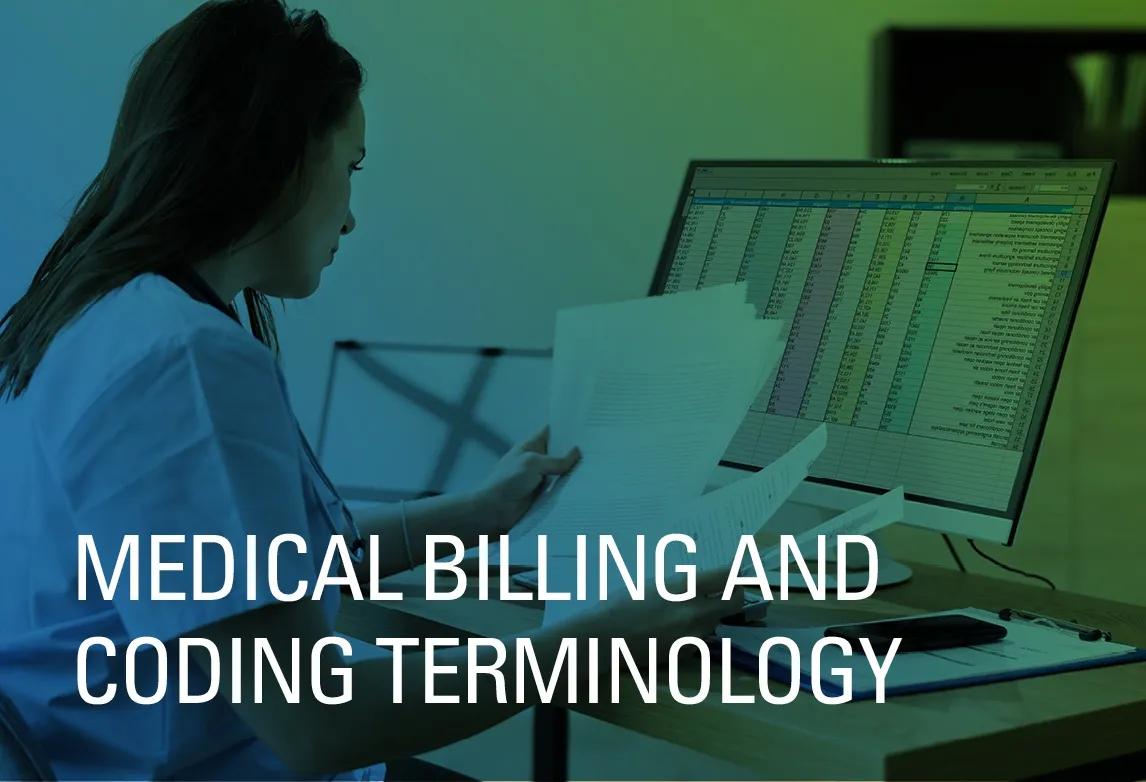Table of contents
What Does a Medical Coder Do?: A Day in the Life

Table of Contents
Key Insights:
- A medical coder translates patients’ health information into universal codes. These codes let insurance companies know how much to reimburse the provider, telling providers how much to bill patients for their portion of the expenses.
- Medical coding job duties include prioritizing patient files and translating patients’ diagnoses, treatment, and other health information into the proper codes. Some medical coders may also be assigned to perform other tasks (like billing), depending on the employer.
- Taking a medical coding training program helps prepare you for this healthcare role. UMA offers two options — enabling you to choose the one that is best suited for your situation and career goals.
The Bureau of Labor Statistics (BLS) projects that medical secretary occupations, which include medical coders, will grow 4% from 2024 and 2034.1 If you’re looking for a behind-the-scenes healthcare role and enjoy computer work, a medical coding career could be a good fit.
What is medical coding, and what does a medical coder do? We answer these questions and more. We also share an overview of medical coding training and how you can get started pursuing this career path.
What Is a Medical Coder?
Medical coders translate patients’ private health information into standardized codes, which are then used for billing purposes. They do this using universal coding systems, making sure they select the proper codes, so insurance claims aren’t denied.
Every time a doctor, nurse, or other healthcare provider performs a service, a code is assigned to the diagnosis and/or procedure. For example, assume a patient goes into a medical office for an X-ray. Once the X-ray is complete, the technician notes the patient’s chart. A doctor then examines the image to diagnose the source of the injury and may also prescribe treatment.
As a medical coder, it’s your job to read these notes and apply the appropriate codes for the X-ray, examination, diagnosis, and any treatment provided. The codes you assign will determine how the medical office bills the insurance company for the patient’s visit.
Jobs that involve medical coding
Medical coders may work in different positions with a variety of job titles. Jobs that involve medical coding include:
- Medical Office Assistant
- Medical Receptionist
- Medical Biller / Coder
- Insurance Benefits Specialist
Where do medical coders work?
Some medical coders work in hospitals or doctors’ offices. Others work for insurance companies or other healthcare organizations. Hospitals and larger healthcare facilities sometimes have separate coding and billing departments. However, if you work in a small office, you might be responsible for medical coding and medical billing. A person who performs both functions is called a medical biller and coder.
Both types of work settings have their advantages. Hospital settings, for instance, may seem more demanding because of the number of patients, but they also often employ several medical coders. When colleagues share the workload, it can help keep things manageable. Plus, having access to experienced coding staff can make it easier for a new medical coder to learn the ropes.
Smaller offices and private practices can also be appealing work environments for medical coders. This type of setting can make it easier to build relationships with other staff and regular patients. You may also have an opportunity to learn other aspects of medical office work on the job, which can enhance your experience and qualifications.
What Does a Medical Coder Do?
A medical coder’s main job task is to assign patients’ diagnoses, treatments, and other procedures the correct standardized codes. These codes tell insurance companies how much they must reimburse the provider. This work requires a high level of organization, along with a strong knowledge of medical terminology.
Different employers may assign different types of medical coding tasks. In a small practice, you might be responsible for processing all patient charts, while a large hospital may have you specialize in one area of coding. For example, you might work solely with inpatient surgeries or with outpatient surgeries, or you may work as an auditor who checks other coders’ work for accuracy.
When the work is divided between medical billing specialists and medical coding specialists, coders primarily focus on updating patient health records and verifying they are properly coded, while billers submit and follow up on claims with insurance companies.
It’s important to remember that medical billing and medical coding are two different job functions. Some offices may have one person perform both tasks, though larger facilities may employ separate billing and coding specialists. You can learn more by watching this short video: What Is Medical Billing and Coding?
A Day in the Life of a Medical Coder
Here’s an example of what a typical day in the life of a medical coder might look like.
Start of a medical coder’s work day
Your day may begin by logging into your computer and opening the programs you need to do your job. You’ll likely have one or more medical coding databases to sign into, along with any other software programs your employer uses.
Once all your programs are open, you might check for updated patient charts, prioritizing them to decide which ones to handle first. Your training can help you determine which charts are urgent and which ones can wait.
Mid-day medical coder tasks
After prioritizing patient charts, you may spend most of your day performing a variety of coding tasks. In addition to assigning codes, you could be reviewing medical charts, taking notes, and possibly assisting with billing. Your employer might have expectations as to how many charts you need to complete each day, so it’s important to manage your time wisely.
If your job includes both coding and billing duties, you may want to experiment with different strategies to learn which ones help you work efficiently. Does it make sense to complete all the coding first before switching to billing tasks, for example? Or is it faster to code and bill for each patient visit as you work your way through the charts?
End of the medical coder’s work day
At the end of the day, you’ll save your work and log out of all the computer programs. You might also ensure that paper-based records are properly filed or securely disposed of. Due to patient privacy and confidentiality laws, you don’t want to leave health records visible to unauthorized individuals who may walk past your desk.
If you’re employed by a large healthcare facility that has medical coders working on multiple shifts, you may need to clear off your desk space to give the next shift’s coder space to work. You could also use the end of your workday to review and prioritize the next day’s charts so you’re ready to go when you return.
How to Become a Medical Coder
If you’re interested in medical coding, you generally need a high school diploma, GED, or equivalent, according to the BLS.2 Some people receive no formalized training and learn on the job. Others enroll in a medical coding training program.
Why pursue medical coding training?
A medical coding program gives you the knowledge and skills needed to perform job duties typically assigned to this role. You also learn the medical terminology and other skills you’re likely to need when coding within the healthcare field.
Additionally, some employers prefer candidates who’ve completed formal training. Even if they don’t, completing a medical coding program can help you stand out from job candidates who lack this type of education.
Medical coding diploma vs. degree
When selecting a medical coding program, you may choose between a diploma or degree. You can generally earn a diploma in under a year, while an associate degree program may take eighteen months to two years to complete. Exact completion time can depend on the specific program and the pace of the individual student.
A medical coding diploma program can be an appealing choice if you want to start pursuing a career in this field sooner. Conversely, an associate degree can be a good option if you want to enhance your credentials or potentially pursue a higher-level degree later in your career.
Online medical coding training vs. on-campus courses
Another factor to consider when choosing a training program is whether you want to take courses online or in person.
Online medical coding training enables you to complete your coursework when it’s most convenient for you. Instructors set deadlines for the coursework, but it’s up to you whether you study or do your assignments at 2:00 a.m., 2:00 p.m., or sometime in between. This can be helpful if you’re working and/or taking care of a family while pursuing your education.
If a nearby campus offers medical coding training, this may be an option as well. Maybe you learn better in person or don’t mind commuting to and from classes. Then on-campus programs may be more appealing to you.
Medical coding training with CPC certification prep
Some programs also prepare you to sit for relevant certification exams, such as the Certified Professional Coder (CPC) credential. To earn your certification, you must meet the credentialing agency’s eligibility criteria, take the exam, and achieve a passing score.
For example, it takes two years of on-the-job experience or one year of work experience and the completion of an 80-hour medical coding course to achieve CPC status, according to the American Academy of Professional Coders (AAPC).4
If you haven’t accumulated the required amount of work experience before passing the exam, the AAPC grants a CPC Apprentice or CPC-A certification. This can be updated to full CPC status upon submitting proof that you’ve satisfied the experience requirement.
Are You Ready to Pursue a Medical Coder Career Path?
At this point, you should have a clearer answer to the question: What does a medical coder do? If this career path sounds appealing to you, Ultimate Medical Academy offers two program options:
- Our Medical Billing and Coding Diploma program consists of 39 credits and can be completed in 11 months or more.5
- Our Medical Billing and Coding Associate of Science / Associate of Applied Science Degree program is 63 credits and can be completed in 18 months or more.5 It includes the same core courses as the diploma program, plus general education courses and electives.
Both of these programs prepare you to sit for the CPC certification exam, if eligible.6 Each also provides you with the information and skills needed to work as a medical coder, in addition to increasing your knowledge of medical billing.
Why earn a medical billing and coding diploma or degree if you only plan to work as a medical coder?
Some employers only hire individuals who can perform both functions. A medical billing and coding education prepares you for these dual medical billing and coding roles. Understanding the medical billing process can also help you recognize the importance of assigning the proper codes when it comes to insurance reimbursement.
Contact us to learn more about the medical coder role or to discuss program enrollment. Our caring and compassionate team members are here to answer your questions and will support you any way they can in your healthcare career journey. With UMA, our learners come first.
FAQs
- Why is medical coding important? Patient health information must be translated into universal codes before providers can submit for reimbursement from insurance companies. This makes medical coding important for receiving payment for products and/or services provided. Additionally, assigning the correct medical codes can help reduce the risk that an insurance claim will be denied. Claims denials can delay reimbursement, which can affect a healthcare organization’s financial health and status.
- How long does it take to become a medical coder? If you pursue a medical coding diploma or degree, it may take you 11 to 18 months or more to complete your schooling, depending on the program length and your individual pace. A diploma can get you into this field quicker, while a degree provides a rounded knowledge base that can enhance your credentials and/or prepare you for additional schooling should you decide to further your education.
- How to learn medical coding? Some people learn on the job. You can also take a medical coding training program or a medical billing and coding program to learn the skills that are important in this field.
- What does medical coding look like? Here’s an example: Imagine that you are a medical coder and you receive a file for a patient who was diagnosed with COVID-19. It would be your job to translate this diagnosis into the proper medical code, which is U07.1.7 Read our blog, “What Is Medical Coding?” for another example, if you’d like to see a different one.
- How to get into medical coding? While some enter this field with on-the-job training, additional training may be required to learn the terminology you’ll need to know.2 A medical coding program can provide this knowledge, in addition to giving you the skills needed to perform job duties typically assigned to this healthcare role.
- Is medical coding a good career? Only you can decide if medical coding is a good career choice for you. If you’re unsure, reach out and let’s talk about your options. You can also take our short Healthcare Career Quiz to learn about roles that may be a good fit for you based on your interests and goals.
- How to get medical coding certification? Earning your certification typically requires that you take and pass a competency exam that tests your knowledge in relevant areas. Other eligibility requirements may apply, such as needing a certain amount of work experience, passing a background check, and more. Both of UMA’s programs prepare you to sit for the CPC certification exam administered by the AAPC, if eligible,6 should you decide to pursue this certification.
- Do medical coders work from home? It depends on the employer. Some healthcare organizations hire remote medical coders, whereas others require these employees to perform their duties in person. Check with the employers you’re interested in working for to learn whether they allow their medical coders to work from home.
- How hard is medical coding? What may feel hard to one person can feel easy to another. If you’re concerned about whether this may be a difficult career for you, read our blog: “Is Medical Billing and Coding Hard? What You Should Know About This Career Path.” This can provide the information you need to help you answer this question for you.
1 Bureau of Labor Statistics. Occupational Outlook Handbook. Secretaries and Administrative Assistants. Job Outlook. https://www.bls.gov/ooh/office-and-administrative-support/secretaries-and-administrative-assistants.htm#tab-6
2 Bureau of Labor Statistics. Occupational Outlook Handbook. Secretaries and Administrative Assistants. How to Become a Secretary or Administrative Assistant. https://www.bls.gov/ooh/office-and-administrative-support/secretaries-and-administrative-assistants.htm#tab-4
3 Tuition considerations and credit transfer decisions are at the discretion of the receiving institution.
4 AAPC. Complete your CPC or COC apprenticeship. https://www.aapc.com/certifications/cpc/complete-your-cpc-apprenticeship
5 Completion time can vary depending on the individual student.
6 Learners must meet eligibility criteria to sit for applicable certification exams.
7 AAFP. Six codes to remember as COVID-19 cases surge across the country. https://www.aafp.org/pubs/fpm/blogs/inpractice/entry/key_covid_codes.html
Request Information
Talk with us. Start your journey.
Complete this form and we'll call you to explore options at UMA and answer your questions. We'll also email you info on how to get started. We're with you at every step!
Request Information
Talk with us. Start your journey.
Complete this form and we'll call you to explore options at UMA and answer your questions. We'll also email you info on how to get started. We're with you at every step!
About the Author
 Christina DeBusk
Christina DeBuskChristina DeBusk is a freelance writer who has been providing health and wellness content to healthcare organizations such as the American Chiropractic Association and International Sports Sciences Association (ISSA) since 2011. She obtained her Bachelor of Science in Sociology from Central Michigan University, minoring in psychology. She has also earned several ISSA certifications, including Certified Personal Trainer and Certified Nutrition Specialist, achieving the status of Elite Trainer.
Related Content


